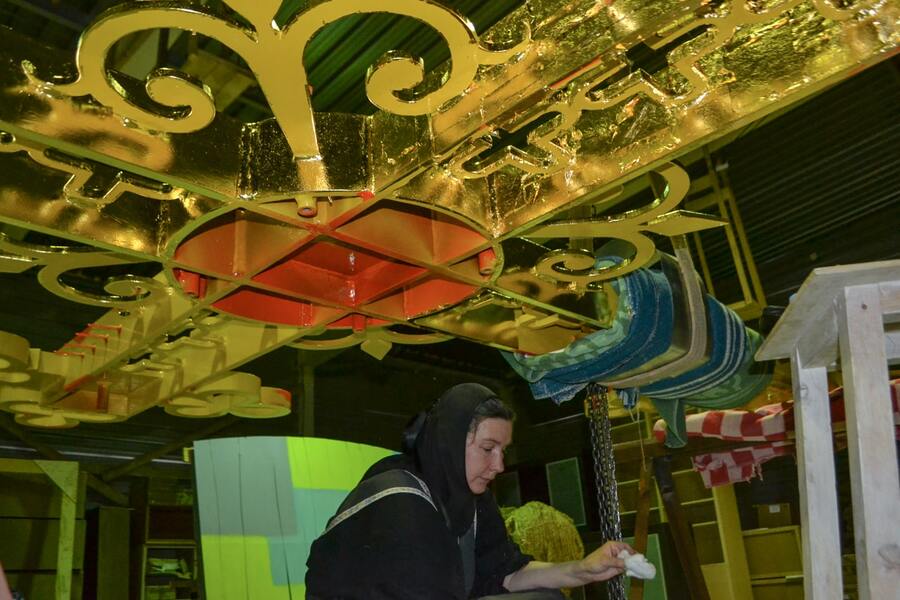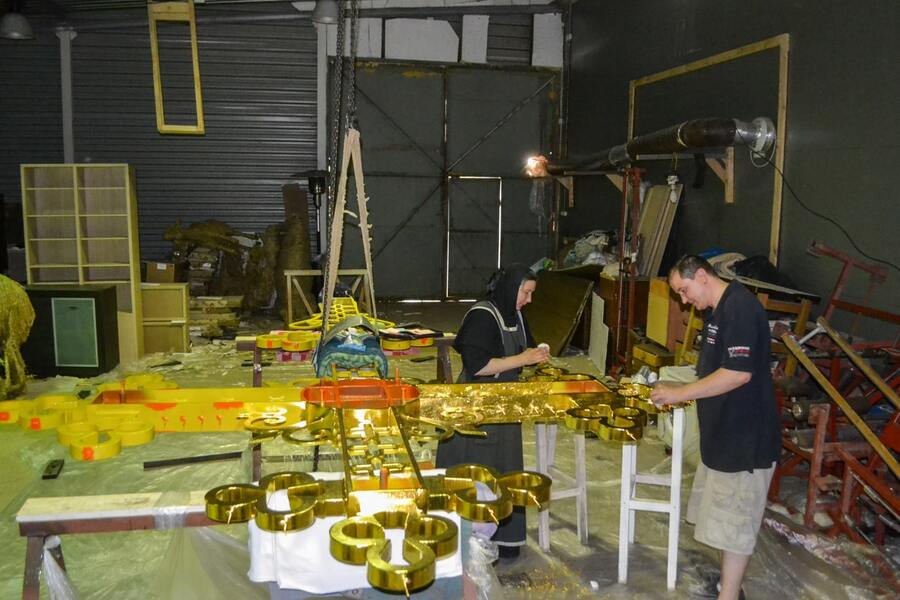
The gilding workshop was opened in 2006 with the blessing from the Convent’s spiritual father, Archpriest Andrey Lemeshonok.
Over the years, the artists have developed their techniques and improved their skills. Many people came, but few have remained to do the hard and strenuous job of a gilder. To do the job well, the artist must possess a lot of physical stamina, quick reflexes, and a lot of patience and concentration. This is not the whole list of traits needed. The success of the process is fully dependent on the inner state of the artist. The artist must approach the task at peace with himself. He cannot do his job well without calmness of spirit. A quiet and prayerful atmosphere is a key prerequisite to a successful project.
Gilding has been practised for more than 4,000 years, The practice of gilding church domes began in Byzantium. For the Orthodox faithful, gold is a symbol of integrity, eternity and divine glory. Gold is also prized for its physical properties. Gilded church domes have a special glow that symbolises a perpetual struggle for faith and goodness.
Up until a few centuries ago, the fire gilding technique was the most common. It involved heating a gilding mix containing mercury, which was heated until all the mercury evaporated. The process was repeated multiple times until the gold was reliably attached to the copper surface of the dome. Finishing just one dome would sometimes cost the artist his health or even his life. The techniques used nowadays are much safer, but a gilder’s job is still highly strenuous and physically demanding. The gilding process is still done entirely by hand and has remained very time consuming and quite hazardous. It sometimes takes the artist several months to complete a single project.
The main material used is gold leaf. This is an alloy of gold, silver and copper flattened into very fine sheets. A single sheet may have dozens of hues. The material is extremely fragile. One careless move can cause the sheet to roll up and become unusable. To prevent this, the sheets are supplied in bundles or booklets.
Most artists add great value to sheets that are thin enough to let the light through. The type of gilding on a dome can be determined by several characteristic signs. Domes gilded with gold sheets have a special glow and iridescence. The glow has a somewhat darkish hue if titan nitride or some other alloy was used. The character of the glow also depends on the type of surface preparation process that was used.
A variety of gilding techniques are available. Galvanic is a method for minimising layer thickness. Poliment gilding is one of the most complex, labour intensive and expensive methods. The gold is polished with a special type of agate sponge making the surface appear as if it was made of cast gold. Mardan gilding is the most common technique suitable for wood and metal surfaces, giving them a noble shine. A variant of this technique used in the old times involved polishing the target surface with garlic. Garlic was rubbed into the surface, and the result of the gilding was not just a shine, but a bright glow.

What does the gilding process look like? Let us answer this question using the example of a wooden item. The process begins with the application of the gesso, a mixture of boiled chalk and glue. The gesso is applied layer after layer. The artist then uses sandpaper of different grain sizes to polish the surface to ebony smoothness. The aim is to achieve perfection not only of the forms but also of the smallest details of the ornament. Once this stage is complete, the polished surface is treated with special compounds and an adhesive. The gilding stage does not begin before this point. Fine sheets of gold are applied to the surface to underline the elegance of forms, the intricacies of the ornament and add perfection of the colours and hues, and a glow from within.
The workshop performs gilding of products with surfaces of iron, wood and other solid materials, and accepts orders for restoration of gilded surfaces.